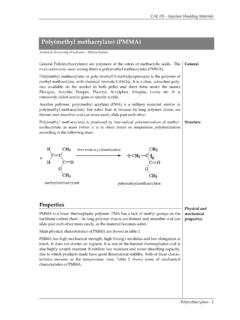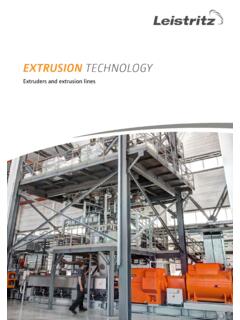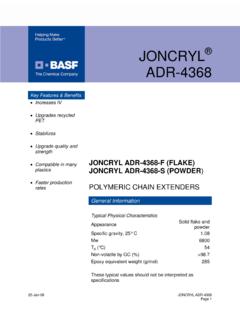Transcription of Melt Flow Index - Plastics World
1 MASTERBATCHESMelt Flow IndexMelt Flow IndexOne of the properties most often quoted for both natural polymersand masterbatches is melt Flow Index (MFI).What is MFI and why is it significant ? melt Flow Index is the output rate (flow) in grammes that occurs in 10 minutes through a standard die of mm diameterand in length when a fixed pressure is applied tothe melt via a piston and a load of total mass of kg at a temperature of 190 C (some polymers are measured at a highertemperature, some use different weights and some even differentorifice sizes).
2 melt Flow Index is an assessment of average molecular mass andis an inverse measure of the melt viscosity; in other words, the highera MFI, the more polymer flows under test conditions. Knowing theMFI of a polymer is vital to anticipating and controlling its processing. Generally, higher MFI polymers are used in injectionmoulding, and lower MFI polymers are used with blow moulding orextrusion affects the melt flow properties of polymers ?Many factors affect polymers' flow properties. Molecular weightdistribution, the presence of co-monomers, the degree of chainbranching and crystallinity influence a polymer's MFI as well asheat transfer in polymer is MFI important to masterbatches ?
3 In addition to its importance to natural polymers, the MFI of amasterbatch is also important because the MFI indicates the relative ease with which a masterbatch can be distributed during a compounding operation or in injection moulding machines, film extruders, Properties of Masterbatches of CarbonBlack in melt Index Low Density PolyethyleneMFIg/10 min(190 C - 10 kg) Carbon Black20 NANOMETRE BLACK60 NANOMETRE BLACKT hough all fillers and additives influence the flow properties of masterbatches, which ones have the greatest effect ?
4 Carbon blacks have the most pronounced effect, and unless veryhigh flow polymers are used as carriers, resultant masterbatcheshave little or no flow when measured using a standard kgweight. For this reason most data sheets quote values measuredusing higher weights ( kg). For example, a typical masterbatchcontaining 40% carbon black in LDPE could have the followingflow rates all measured at 190 C:Test weight (kg)MFI (g/10 min.) < 1 The main parameters of carbon blacks that influence the MFI arethe particle size, structure and surface chemistry.
5 melt viscosityof polymer carbon black mixtures increases as the carbonblack content increases and also the particle size of the blackdecreases. Narrow carbon black particle size distribution alsoleads to higher viscosity; this reinforcing characteristic of carbonblacks limits the practical levels at which they can be incorporatedinto thermoplastic polymers. Although there are some exceptions,50% is widely accepted as the upper limit for 60 nanometre particlesize carbon blacks incorporation with resin and 40% for 20 nanometre of particle size on flow over a range of carbon black loadings is shown, as an example, in the following graph:How does someone choose a masterbatch for a specificuse ?
6 The ideal choice of a masterbatch for a specific end use is one thatmatches the MFI of the masterbatch as closely as possible with theMFI of the base is reasonably easy to do with titanium dioxide-based (white) masterbatches and some additive masterbatches, but not as simplewith black masterbatch because of the reinforcing nature the masterbatch is to be compounded into the base polymerusing, for example, high shear mixing equipment, an internal mixeror twin screw extruder, it is possible to choose a fairly low MFI carrier resin and still achieve excellent incorporation.
7 Polymer producers generally follow this practice when making pipe or cablecompounds in order not to affect the final performance propertiesof the poor distribution occurs when simultaneously feeding masterbatchand resin into an injection moulding or extrusion process where the shear forces are somewhat lower, the processor can adjustequipment operation conditions (such as increased back pressure,use of turbine mixing heads, or cavity transfer mixers at the end ofthe extruder screw ). To maintain output rates, usually the processorspecifies a masterbatch that is compatible with the base resin andthe operating necessary, adjustments to increase the MFI of black masterbatchesare suggestions are to use: a higher flow carrier resin; a less reinforcing grade of carbon black; or process aids ( stearates).
8 If none of these are acceptable, then reducing the carbon blackcontent in the masterbatch may be the only answer (for exampleuse a 25% or 30% masterbatch instead of a 40% or 50%).When combinations of masterbatches are used, the high flow nature of one can adversely affect the proper incorporation of theother. In the manufacture of tackified silage film, for instance, somemanufacturers add a PIB masterbatch (PIB = polyisobutylene) andblack masterbatch simultaneoulsy. If distribution problems occurbecause the PIB reduces the shear in the system, the blackmasterbatch must be dioxide-based masterbatches (white), inert filler master-batches, and additive masterbatches (for example, UV stabilisers)
9 Affect processing differently than carbon black materials like titanium dioxide and calcium carbonate donot have a significant reinforcing effect on resins, meaningful MFIvalues using a kg weight can be measured, and much closermatching of masterbatch and base resin in MFI is possible evenwith loadings as high as 80%. Take, for example, a 75% titaniumdioxide pigment masterbatch incorporating an LDPE carrier of meltindex 20 gr/10 min. This masterbatch would have a melt indexsomewhere around 4 gr/10 min ( Kg/190 C), which is similar toa melt Index of 2 gr/10 min.
10 (LDPE film grade commonly used byprocessors). Thus, the masterbatch and dilutent polymers meltindices are broadly of the additives used in additive masterbatches are low melting point materials (UV stabilisers, slip agents such as oleamidesor erucamides, or antistatic agents) and can melt before the carrierresin causing difficulties for the masterbatch producer and significantly increasing the effective MFI of the is vital knowledge for polymer processing. If you want to findout more about MFI, you can refer to the following references: ASTM Standard D1238 "Standard Test Method for Flow Ratiosof Thermoplastics by Extrusion Plastometer" ISO1133 " Plastics - Determination of the melt Mass-Flow Rate(MFR) and melt Volume-Flow Rate (MVR) of Thermoplastics".











